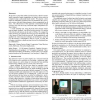Free Online Productivity Tools
i2Speak
i2Symbol
i2OCR
iTex2Img
iWeb2Print
iWeb2Shot
i2Type
iPdf2Split
iPdf2Merge
i2Bopomofo
i2Arabic
i2Style
i2Image
i2PDF
iLatex2Rtf
Sci2ools
VR
2007
IEEE
2007
IEEE
Effective Cooperative Haptic Interaction over the Internet
We present a system that enables, for the first time, effective transatlantic cooperative haptic manipulation of objects whose motion is computed using a physically-based model. We propose a technique for maintaining synchrony between simulations in a peer-topeer system, while providing responsive direct manipulation for all users. The effectiveness of this approach is determined through extensive user trials involving concurrent haptic manipulation of a shared object. A CAD assembly task, using physically-based motion simulation and haptic feedback, was carried out between the USA and the UK with network latencies in the order of 120ms. We compare the effects of latency on synchrony between peers over the Internet with a low latency (0.5ms) local area network. Both quantitatively and qualitatively, when using our technique, the performance achieved over the Internet is comparable to that on a LAN. As such, this technique constitutes a significant step forward for distributed haptic...
Concurrent Haptic Manipulation | Cooperative Haptic Manipulation | Haptic Manipulation | Virtual Reality | VR 2007 |
| Added | 04 Jun 2010 |
| Updated | 04 Jun 2010 |
| Type | Conference |
| Year | 2007 |
| Where | VR |
| Authors | Mashhuda Glencross, Caroline Jay, Jeff Feasel, Luv Kohli, Mary C. Whitton, Roger J. Hubbold |
Comments (0)

